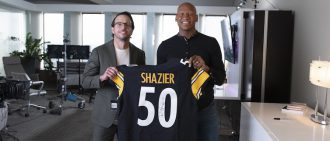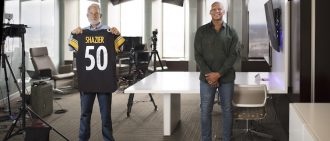When James Conner returned to the football field after battling cancer, being drafted by the Pittsburgh Steelers, and achieving his dream of playing in the National Football League (NFL), he realized something.
His story — returning to on-field stardom after beating Hodgkin’s lymphoma — inspired people. He knew that from the heartfelt social media messages and stories he heard from people battling injury and illness when he visited hospitals.
But it wasn’t until after his 2017 rookie season in the NFL that he truly understood the power of his story. That what he had done and continued to do off the field meant more to many people than what he accomplished on the field.
“Being an inspiration to the cancer community and people who are dealing with hardships is way more of an influence than just running a football,” James says. “A lot of people can run fast, jump high and carry the football up and down the field. But I feel like I can give inspiration in a much bigger way than just doing that.”
James has fully embraced that role.
Since his initial diagnosis of Hodgkin’s lymphoma in 2015, he has become a model for people battling any type of adversity. A fourth-year member of the Steelers — and a Pro Bowl running back — he steps on the field every day thinking of the many people he’s playing for.
“There are a lot of people who would love to take that field on Sundays at Heinz Field, with the fans going crazy and playing on TV and all that,” he says. “It’s definitely an honor. But I’ve met a lot of people who had the game taken away from them.
“I know what it’s like to have it taken from you for a short period of time. I was fortunate enough to get back to it. But there are others who can’t get back to it, so I think you play for them, and you honor them by how you approach it.”
Ryan Shazier's 50 Phenoms Season 2
‘Are You Going to Keep Fighting?’
The story is well-known.
Entering the 2015 season at the University of Pittsburgh, James Conner was coming off an outstanding sophomore year. He was named Atlantic Coast Conference Player of the Year in 2014. He hoped a strong junior year would put him in position to potentially get drafted into the NFL.
Then he suffered a serious knee injury — a torn medial collateral ligament (MCL) — in September 2015. His season was over.
The news was crushing to James. It meant his NFL dreams were temporarily on hold.
He would soon get even more shocking news.
As James rehabbed his injured knee, he felt fatigued. He had trouble sleeping and suffered from night sweats. In November, he had a chest x-ray, and then a PET scan. On Thanksgiving, his doctor called to tell him it appeared he had lymphoma. A biopsy confirmed the diagnosis.
James had stage 2 Hodgkin’s lymphoma, a blood cancer that affects the immune system. If caught early, it can be treated effectively.
The diagnosis stunned James, but he knew he couldn’t let it beat him. His doctor — Stanley Marks, MD, chairman of UPMC Hillman Cancer Center — told him his lymphoma had a high cure rate. James focused on that as he began treatment.
“I really turned to my faith and looked within and said, ‘How are you going to handle this?'” says James. “‘Are you going to let it eat you up, or are you going to keep fighting?’ It’s a whole mindset that you have to tap into that I didn’t even know that I had. But when you get put into a situation where that’s the only choice, I think I just pushed through.”
He told the team of his diagnosis soon afterward. In December, he revealed it publicly at a press conference.
“Fear is a choice,” he said at that press conference. “I choose not to fear cancer.”
He fought through six months of grueling chemotherapy treatment. The day after chemo, he worked out while wearing a surgical mask.
“It was tough. It was difficult,” he says. “I had to go real slow, but I think I developed patience. You fight these little battles, but that prepares you. That makes you appreciate the journey. It makes you appreciate the slow route. You just learn to trust the plan.”
Never Miss a Beat!
Subscribe for articles and more from Ryan Shazier’s 50 Phenoms.
Thank you for subscribing!
You can now select the specific newsletters you'd like to receive.
You are already subscribed.
Subscribe to more newsletters in our email preference center.
Sorry, an error occurred. Please try again later.
Get Healthy Tips Sent to Your Phone!
‘It’s About Helping One Another’
James didn’t know how he felt about being known as “the football player who beat cancer.”
When he rejoined his Pitt teammates for workouts while still undergoing treatment, he wore a surgical mask for protection. After six months of chemotherapy, a PET scan in May 2016 showed his cancer was in complete remission. He returned to the field that fall and was named an all-conference running back. In April 2017, his NFL dreams became reality when the Steelers drafted him in the third round.
James knew his comeback inspired people. But at the time, his top priority was football.
“I knew that it was going to be a big story and everybody was anticipating my return to the field,” he says. “I was just so focused on having a big game for my first game back, doing well that season, and then getting drafted.”
Seeing the messages on social media and hearing what people said on his hospital visits, James realized his journey was something bigger. He talked to his loved ones, who told him he could be more than just a football star.
“I think that’s part of the faith journey that I started to embark on — realizing that we’re all God’s people, and it’s about helping one another instead of being selfishly driven,” says James.
“There’s nothing wrong with wanting for yourself, nothing at all wrong with that. But it’s also about how many people you bring up on your way up. I just had to take a step back and realize that.”
‘This Is My Calling’
During his cancer treatments, James sat in the same room with other patients undergoing chemotherapy. He met people both young and old who were fighting the same battle. One man had been going through cancer treatments for several years.
“I just learned perspective, that everybody’s dealing with things,” he says. “I did have all the attention and media on me, but I was no different from the person next to me who was going through cancer.”
As much as he inspires other people, James also draws inspiration from them — fellow cancer patients as well as the many people he’s met in hospitals or on social media.
The MCL injury that James originally thought was a curse turned out to be a blessing, he says. If it weren’t for that knee injury, he might not have found out about the cancer at such an early stage, and it might not have been so treatable. And without cancer, he wouldn’t have met the doctors, nurses, and countless other people who inspire him.
“Cancer survivors and the cancer community, I feel like I have a special bond with all of them,” he says. “And not even just cancer, but anybody dealing with hardships and adversity. Because each and everybody’s low point in life is different. You just pray that you have the strength to deal with a low point.”
Knowing he continues to inspire people, James collaborated with author Tiffany Yecke Brooks to write an autobiography.
The book — titled “Fear Is a Choice” for the words he spoke when he announced his cancer diagnosis — was released in June 2020. He hopes the book brings inspiration and hope to people battling any kind of adversity.
“Early on, I did want to be a football player first,” says James. “But this is so much bigger than football. This is my calling. God made me go through it for a reason and get through it for a reason — to show it can be done.”
About UPMC Hillman Cancer Center
When you are facing cancer, you need the best care possible. UPMC Hillman Cancer Center provides world-class cancer care, from diagnosis to treatment, to help you in your cancer battle. We are the only comprehensive cancer center in our region, as designated by the National Cancer Institute. We have more than 70 locations throughout Pennsylvania, Ohio, and New York, with more than 200 oncologists – making it easier for you to find world-class care close to home. Our internationally renowned research team is striving to find new advances in prevention, detection, and treatment. Most of all, we are here for you. Our patient-first approach aims to provide you and your loved ones the care and support you need. To find a provider near you, visit our website.







